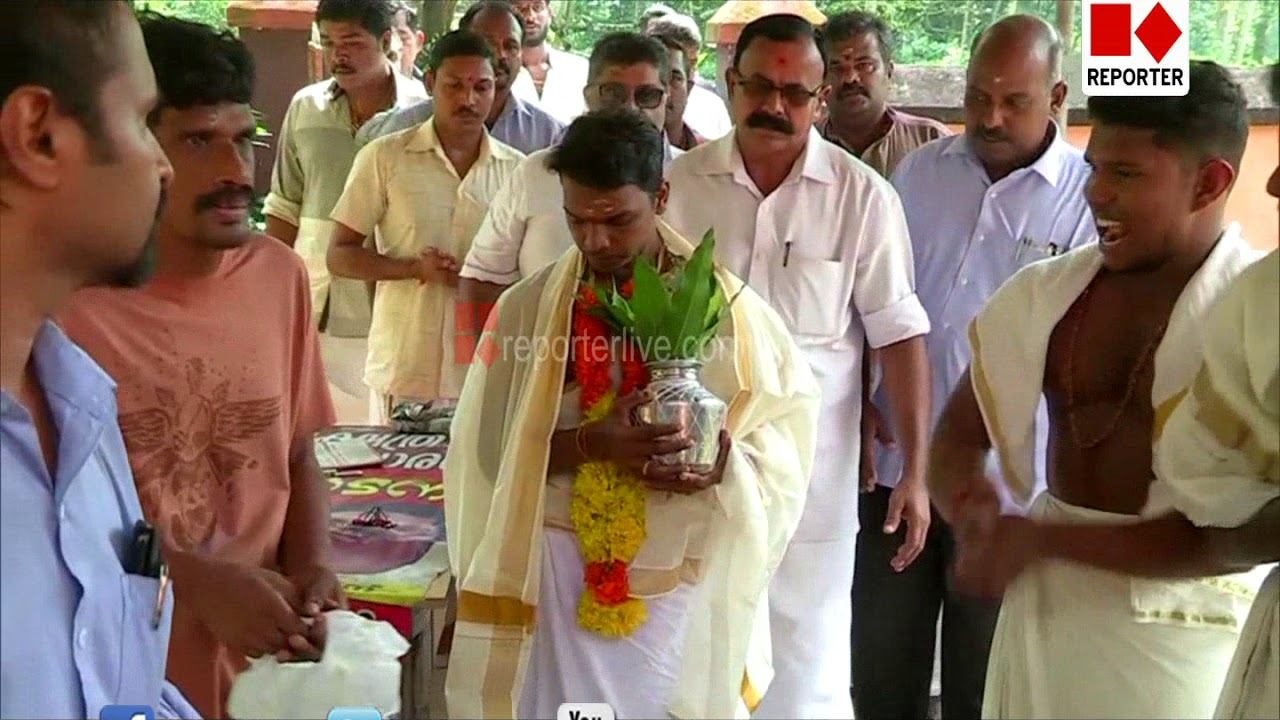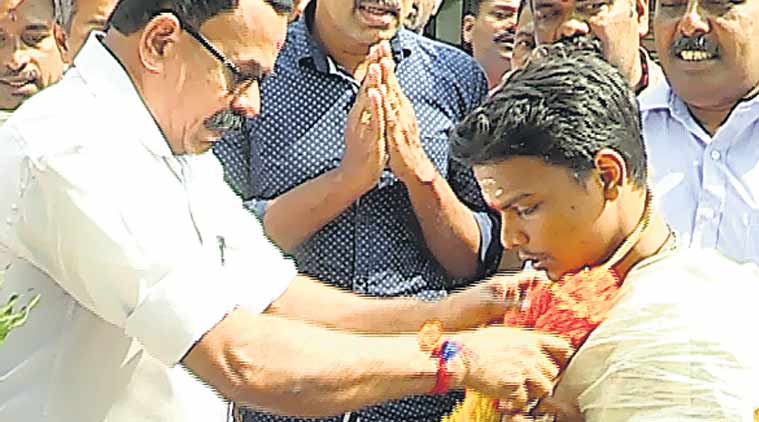
When Yadu Krishnan (22) entered the sanctum sanctorum of Keecherival Shiv Temple in Pathanamthitta district of Kerala an age-old Indian Belief was shaken. People of the village welcomed him with the garland of flowers and traditional Drums that were once reserved for the Brahmin Tantries and Priests.
The rank list available in the website of Travancore Devaswam Board places Yadu Krishna in the fourth position and brackets his name as Pulaya/SC. He is the first Dalit to enter as Santhi (priest) in a Government controlled Temple in Kerala. The same rank list selected five other Dalits and 30 non-Brahmins to the post of Santhies in various temples.
The political decision from the left Government and the forward-looking attitude of the present selection committee was evident in the list. In the list of 62 candidates, 36 are from non-Brahmin communities, mostly from Ezhava and Nair origin.
Less than a dozen of Ezhava (a backward class in Kerala) and Nair (a non-Brahmin forward class) candidates were selected for the post in the past decade. But, it is for the first time that Dalits were included. Consider Santhi as a job, it is indeed a welcome step; consider the entry as historic, it is marvelous; consider the time we live in, it is undoubtedly hopeful.
Why it is Historical
More than 15,000 temples; of which 1343 belongs to the Malabar Devaswam board, 1246 to the Travancore Devaswam Board, 353 to Cochin Devaswam Board and the rest in the hands of Private Trusts, Uranma Devaswams, Sree Narayana Dharma Paripalana Yogam, Nair Service society and individual families. Whoever be the custodian, the control is in the hands of Brahmins as elsewhere in India.
Those 15,000 temples engage about 25,000 priests and 95 % of them are from the Brahmin community, who were only 1.76 % of the population of Kerala (Total population of Kerala 3.3 Crores- Brahmins 3.36 lakhs.) As it is a male-only world the selection comes from 1.7 lakh population. If we shortlist further after omitting children and senior citizens employable number of Brahmins will come down to 65,000. Of that 65,000 more than fifty percent are Doctors, Engineers and Civil Servants working in India and abroad. All the rest got employment in Temples as priests with government guaranteed salary and pension. More than as an employee they took the reins of temples to control the devotees and society to a larger extent.
Now, the Kerala government had decided to break the hard coconut of Brahminical supremacy and took a bold step. Travancore Devaswam Board, the custodian of 1246 Temples in Kerala, for the first time in its history appointed six Dalits as Santhi. However, it should also be noted that Malabar Devaswam board and Cochin Devaswam Board do not appoint non-Brahmin priest.
It is historic because all the temples under Devaswam Board were controlled by Brahmin priests. The Brahmin Tantries were above the Board and took decisions on daily rituals and governance. For instance, if it is Sabarimala-the most sought after pilgrim centre, Gurvayoor-temple of conservative rituals and Sree Padmanabha Swamy Temple-one of the richest temple in the country, the final decision has to come from a Brahmin Tantri or a Brahminical Trust. The scenario is gradually changing.
A short look back
If the cultural invasions, and of course distortions, had a preserved monument, it is situated therein Andalur Kavu near Dharmadom – the assembly constituency of Pinarayi Vijayan, the chief minister of Kerala. The two temple structure with Melekavu and Keezhkavu (Upper Temple and Lower Temple) narrate the way how Brahminical priest-hood entered Kerala.
In the Melekavu the deity is of Sree Rama. When it comes to Keezhkavu the rituals take a complete U-turn. It is the only Temple in North Malabar where the Theyyam (the human representative of God) never speaks. When the rest of the Theyyams tells stories, advice people and even settle family feud theTheyyam at Andalur Kavu can’t utter a word.
How did it happen? When Brahmins entered Kerala from Mangalore probably in the eight century (Forgive me for not quoting the story of Parasurama, his creation of Kerala and setting up of Brahmin villages, because, he is somewhere in Vedic Trethayuga and there is no evidence of Brahmins living in Kerala before Eighth Century AD) the first place they conquered and settled is Andalur kavu. Then the Vedic Brahminical Scholarship was challenged by the Palaeolithic Thiyya Teachings mostly of Buddhist origin. The armed Brahmins silenced the Thiyyas; in some stories even cut down the tongue of the then Theyyam in the presence of Samuthiri, the King. Then onwards the Theyyam of Andalur never spoke and the palaeolithic teachings ceased to exist.
Now the Story of Yadu Krishna
On 7th October 2017 in a report published by outlookindia.com, there is an interesting quote. It reads:
“He is now a Brahmin by behaviour, culture, food habit and everything.”
The report is on Yadu Krishna and the quote is from none other than his teacher Anirudhan Thanthri who runs Gurudev Vaidik Tantra Peet in Kochi. Is there something spicy, that demands a second thought?
When the teacher certifies him as a Brahmin by behaviour, culture and food habits he is no longer a Dalit, but a convert to Brahminism. He had trained him to become a Brahmin and not a priest, or more precisely he believes that becoming a Brahmin is the ultimate goal. The teacher certifies that he is no longer a Dalit with his ethnic qualities and behaviours.
When Kerala Government boosted its move of appointing Dalits in Temples, Yogi Aditya Nath the Chief Minister of Utherpredesh replied with a smile and said that they had done it decades before. It is true. The Brahminical theory of Vedic era never insisted that a Brahmin should have a Brahmin Father and Brahmin Mother. The Vedic System needs a certain number of Brahmins to control the society. Whenever the number falls they had recruited from elsewhere. Here comes the great conversion story of Kerala. In the Eighth Century, Sankaracharya took the initiative and reinstalled the Brahminical system across India. He was a Dravidian from Kalady, near Kochi, who transformed himself to a Supreme Brahmin scholar by travelling to the north, might be the first exodus of a Keralite for learning religion. Through that campaign, many were converted to Brahminism across Kerala. They were all Dravidians and Brahminical tradition in Kerala is also the history of conversion.
A set of disturbing question comes here; What is the process of making a Brahmin? Who wants more Brahmins in the system? What is wrong in doing the rituals by continuing the food habits of a Dalit? Which God is afraid of the Ethnic Dalit identity? And, a final question How came that Gods and Goddesses only understand Sanskrit?
Attaining ‘Tat Savitur Vareniam’
All the qualified priests in the Travancore Devaswam Board rank list should have written the Gayatri Mantra. It is about the Varenia (Purest of the pure) God and the way to achieve vareniam. What is that puritanism? Is it quitting beef and start drinking milk?
All the men (sorry, there is no woman) in the merit list should have written the Vedic hymns which worships the Supreme Puritan God. Can we empower the Dalit by converting them to Brahmins? Will the Devaswam Board still allow them to eat beef, mutton, chicken and fish before coming to the temple? When the government took such a positive decision it is disturbing to ask such questions. If we try to answer them it will be even more embarrassing.
Then there is the positive question: Will the Cochin and Malabar Devaswam boards emulate this act?And more importantly, will the Left government and Devaswam boards be bold enough to appoint women priests who qualify the written test and interview?
A.P. Ayyappan is an independent journalist










































